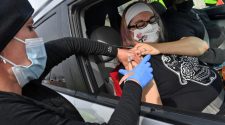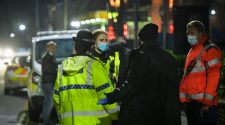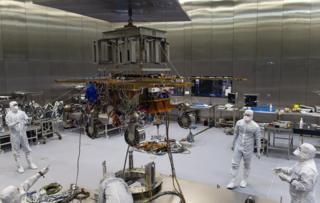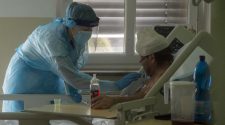Image copyright
Max Alexander/Airbus
Several months of testing now lie ahead for Rosalind Franklin
Assembly of the rover Europe and Russia plan to send to the Red Planet next year is complete.
Engineers at Airbus in Stevenage, UK, will display the finished vehicle on Tuesday ahead of its shipment to France for testing.
Called “Rosalind Franklin” after the British DNA pioneer, the six-wheeled robot will search for life on Mars.
It has a drill to burrow 2m below ground to try to detect the presence of microbes, either living or fossilised.
The project is a joint endeavour of the European and Russian space agencies, with input from the Americans.
Image copyright
Max Alexander
The rover is being bagged and boxed for shipment to Toulouse
Although the rover’s build took just nine months, development work at component and instrument level has consumed more than a decade.
Lift-off atop a Proton rocket is scheduled for July 2020. It is an eight-month cruise to Mars, with the landing on an ancient equatorial plain targeted for 18 March, 2021.
China and the US are preparing their own rovers for launch in the same departure window as Rosalind Franklin.
China’s vehicle, dubbed XH-1, is a slightly smaller concept. The Americans are assembling a near-copy of the one-tonne Curiosity robot that has been investigating the planet for the past seven years. Their machine is codenamed currently simply Mars 2020.

Media playback is unsupported on your device
What still needs to be done?
The roughly 300kg Rosalind Franklin rover is being bagged and boxed, ready to be sent to an Airbus facility in Toulouse where a testing regime will ensure it can withstand the rigours of interplanetary travel.
There are actually three outstanding items yet to be integrated on the robot.
These are the radioisotope heaters that will keep the vehicle warm in the bitter conditions on Mars. But they are a Russian expertise and will not be inserted until just prior to blast-off.
In parallel with the work on the rover, engineers in Italy at the Thales Alenia Space (TAS) company are preparing the mechanisms required to get the rover safely to, and on to, Mars.
In Turin on Tuesday, the cruise spacecraft that will shepherd the robot to the Red Planet, and the descent module, which will protect it as it enters Mars’ atmosphere, will have their first fit-check.
Eventually, all elements of the mission will meet in Cannes, at another TAS factory, for end-to-end mating.
Assuming no problems are found, everything will then be despatched to Baikonur to be placed on top of the Proton.
Rosalind Franklin was “superb scientific tool”, said Dr David Parker, Esa’s director of human and robotic exploration.
“We still have big challenges ahead but mission success is our number one priority.”
Why is this important for the UK?
Tuesday’s send-off in front of the media is a big moment for the UK, which has made the Mars robot a central feature of its space science policy.
Britain has invested in the order of €290m (£260m) in the wider mission, codenamed ExoMars, that also includes a satellite positioned in orbit around the Red Planet. A further £14m (€16m) was set aside specifically for instrumentation contributions on both the rover and the satellite.
UK scientists lead the PanCam (the panoramic camera system on the rover), which will take the pictures that help the robot navigate Mars’ terrain and identify the rocks of greatest interest.
The rover’s name: Who was Rosalind Franklin?
Image copyright
MRC Laboratory of Molecular Biology
The rover is named after the British scientist who helped decipher the structure of DNA
In 1952, Rosalind Franklin was at King’s College London (KCL) investigating the atomic arrangement of DNA, using her skills as an X-ray crystallographer to create images for analysis.
One of her team’s pictures, known as Photo 51, provided the essential insights for Crick and Watson to build the first three-dimensional model of the two-stranded macromolecule.
It was one of the supreme achievements of 20th-Century science, enabling researchers to finally understand how DNA stored, copied and transmitted the genetic “code of life”.
Crick, Watson, and KCL colleague Maurice Wilkins received the 1962 Nobel Prize for the breakthrough.
Franklin’s untimely death meant she could not be considered for the award (Nobels are not awarded posthumously). However, many argue that her contribution has never really been given the attention it deserves, and has even been underplayed.
- BBC – In Our Time: Melvyn Bragg recalls the life of Rosalind Franklin
[email protected] and follow me on Twitter: @BBCAmos

















